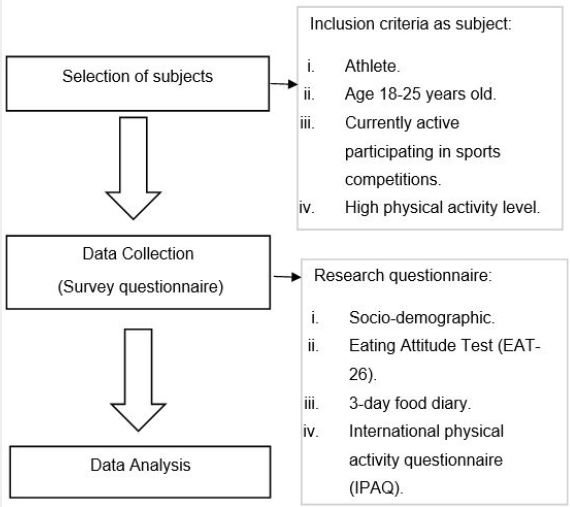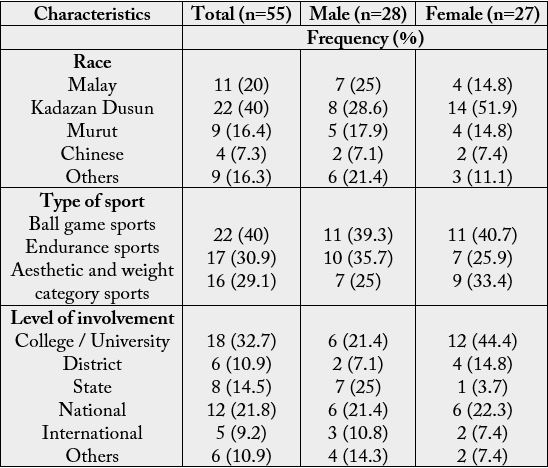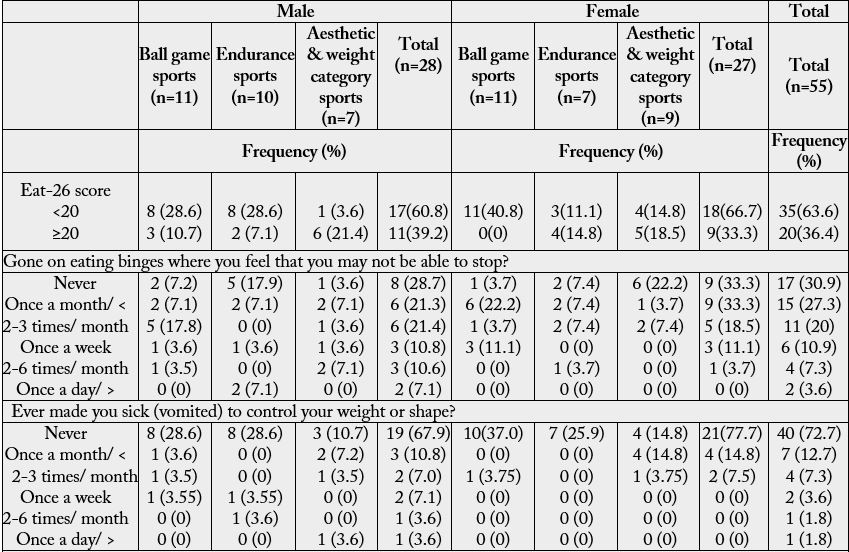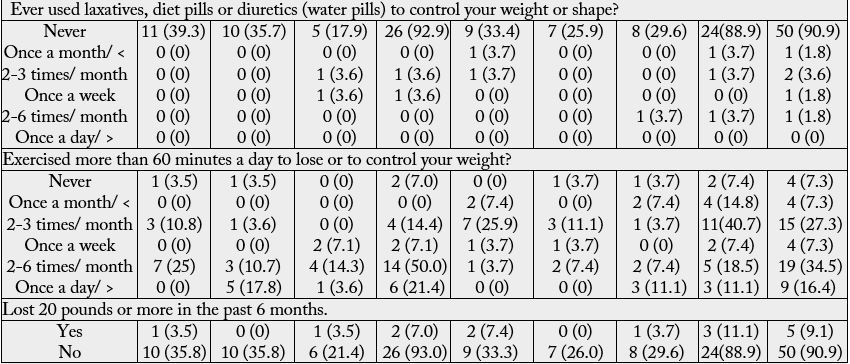Biography
Interests
Chee Ping Fadzel Wong* & Hangerica Harold Sinpong
Nutrition Programme, Faculty of Food Science and Nutrition, Universiti Malaysia Sabah, Jalan UMS, 88400, Kota Kinabalu, Sabah
*Correspondence to: Dr. Chee Ping Fadzel Wong, Nutrition Programme, Faculty of Food Science and Nutrition, Universiti Malaysia Sabah, Jalan UMS, 88400, Kota Kinabalu, Sabah.
Copyright © 2021 Dr. Chee Ping Fadzel Wong, et al. This is an open access article distributed under the Creative Commons Attribution License, which permits unrestricted use, distribution, and reproduction in any medium, provided the original work is properly cited.
Abstract
It is well documented that eating disorders will have a negative impact on health status and athletic
performance. The risks of eating disorders among athletes are required to be detected early before it
affects athlete’s health and exercise performance. To date, there is still scanty information on eating
disorder and nutritional status among young athletes in Sabah.
The objective of this study was to determine eating disorders and nutritional status among young
athletes in Sabah.
A total of 55 young athletes who are active representatives of sports competitions were selected
to participate in this study. Eating attitudes test questionnaires (EAT-26) was used to determine eating disorder risk. International physical activity questionnaire (IPAQ) and 3-days food diary
were used to determine nutritional status and physical activity level. Statistical Package for the
Social Sciences (SPSS) version 27.0 was used to analyse the collected data. Pair-t test was used to
compare energy intake of subjects with the recommended nutrient intake for Malaysia (PAL2.0).
The significant level is p<0.05.
This study found that aesthetic and weight category sports were the highest risk for eating disorder.
Energy intake (kcal/day) in the aesthetic, weight category, endurance and ball games did not
significantly meet the daily energy intake recommendations.
As a conclusion, majority of the subjects did not practicing balanced diet and meet the recommended
nutrient intake (RNI) especially in the aesthetic and weight category sports. These current findings
are useful to detect early eating disorder among young athletes before it become critical and affect
athletes’ exercise performance and health status.
Introduction
Eating disorders are psychological illnesses characterized by severe and persistent eating behavior disorders.
Eating disorders are serious mental illnesses with high mortality rates [1-2] and it can affect any individual
regardless of age, race, ethnicity and gender [3]. Previous studies found that an athlete has a high risk
for eating disorders compared to a non-athlete [4-5]. It is well documented that eating disorders have a
significant negative impact on health status [6-10] and athletic performance [6,10-13]. Many previous
studies reported that female athletes have a higher risk of eating disorders in comparison with male athletes
[14-20]. Female athletes are more concerned with weight and thin appearance that cause female athletes
have a higher eating disorder risk compare to male athletes that are more concerned with muscle mass and
strength [4].
Nutritional status assessment is an effective strategic to detect eating disorders risk among athletes [21]. Therefore, nutritional status assessment can assess a person’s health and help to identify individuals at eating disorder risk. Generally, athletes required a higher energy and nutritional requirements compared to a nonathlete [22,23]. To date, there is still scanty information on eating disorder among young athletes in different categories of sports in Sabah. This study was designed to investigate eating disorders and nutritional status among young athletes in the sports ball, aesthetic, endurance and weigh category sports. The findings of this current research are useful to detect early eating disorder and nutritional problems faced by athletes before it become critical and affect athletes’ health and exercise performance.
Methodology
Fifty five Sabahan young athletes who met the inclusion criteria as subjects were recruited in this study.
This study was conducted online with the use of a survey questionnaire. The questionnaire used in this study
consists of four sections which were socio demographics, Eating Attitude Test (EAT-26), 3-day food diary
and International Physical Activity Questionnaire (IPAQ). The study design is shown in the Figure 1.

EAT-26 questionnaire was used to measure the level of eating disorders risk. EAT-26 consists of 26 questions and has six scales options (‘always’, ‘usually, ‘often’, ‘sometimes’, ‘rarely’ or ‘never’). Questions were divided into three subscales: (a) diet; (b) bulimia and attention towards food; and (c) self-control. There were five behavioral questions. Four questions related to overeating, vomiting, use of laxatives, and exercise as a method of weight control. The questions have six scales options (‘never’, ‘once a month or less’, ‘2-3 times a month’, ‘once a week’, ‘2-6 times a week’, ‘once a day or more’). There was one question related to weight loss and this question has two answer choices (‘yes’, ‘no’). Table 1 is the classification of scores for eating disorders risk.

Subjects recorded all foods and beverages consumed for three days (two weekdays and one weekend) in a 3-day food diary form [21,24,25]. Food quantities were estimated using household measures [24]. The food intake was analyzed using the food composition dietary plus software [26]. International physical activity questionnaire (IPAQ) was used to determine physical activity level of the subjects. The questionnaire was self-reported by the respondents and there were seven question items. The item requires respondents to report the type of activities performed during a week, duration and frequency of each activity. The questionnaire provided information on time spent for walking, doing vigorous and moderate intensity activities as well as sedentary activities. The duration of each activity will be multiplied by the metabolic equivalent of task (MET) value for each activity (MET-min/week). Physical activity level calculation analysis was performed using IPAQ short form scoring software and excel spreadsheet. Data was analyzed using Statistical Package for Social Sciences (SPSS) version 28.0. Pair-t test was used the compare energy intake with the recommended nutrient intake for Malaysia (PAL2.0). All data is presented in mean ± standard deviation. The significant level is p<0.05.
Results and Discussion
A total of 55 young athletes were recruited in this study. The data demographic of subjects are shown in the
table 2. There has 22 subjects (ball game sports), 17 subjects (endurance sports) and 16 subjects (aesthetic
and weight sports) participated in this research. Majority subjects were representing university level in the
sports competition.

Data are expressed in frequency (percentage)
Mean physical activity (MET-min/week) of subjects is shown in the table 3. All subjects have high physical
activity according to the international physical activity questionnaire scoring. High physical activity level is
defined as any one of the following two criteria; Vigorous-intensity activity on at least 3 days and accumulating
at least 1500 MET-minutes/week or 7 or more days of any combination of walking, moderate- or vigorousintensity
activities accumulating at least 3000 MET-minutes/week. This finding was met the inclusion
criterion as subject which only selected subjects who have high physical activity level. Mean energy intake
(kcal/day) of subjects is presented in the table 4. There was a significant differences between daily energy
intake and recommended nutrient intake for Malaysia (PAL2.0) in all sports category (p<0.05). Mean
energy intake for male (1717.7 ± 276.8kcal/ day) and female (1320.1 ± 242.1kcal/ day) athletes did not
achieve the recommended energy intake based on Recommended Nutrient Intake for Malaysia (RNI) (PAL
2.0); males (2800kcal/day) and females (2210kcal/day) aged 18-29 years old. These findings reflected that
majority athletes did not practicing a balanced diet. Previous studies also found similar findings reported
that mean daily energy intake of athletes was less and did not achieve the recommended daily energy
intake [22,27-30]. There are various possibilities that contribute to a low energy intake which did not meet
the recommendations among athletes. It may be due to the athletes tend to engage in unhealthy dietary
behaviors such as limiting food intake, use of diet pills or diuretics to control their body weight [22,24,31].
It may also be due to the lack of nutritional knowledge among athletes and sports coaches on how to lose
weight in an accurate method [32].

Data are expressed in mean± S.D

Data are expressed in mean± S.D
Eating disorder scoring of subjects (EAT-26) is shown in table 5. There are 36.4% (n= 20) of athletes
have a high risk of eating disorders based on the EAT-26 scoring. For male athletes, aesthetic and weight
category sports contributed to the highest risk of eating disorders (n= 6) followed by ball games sports
(n=3) and endurance sports (n=2). Similarly finding also noticed in the female athletes, aesthetic and
weight category sports were the highest risk of eating disorders (n=5) and it was followed by endurance
sports (n=4). These current findings were agreement with the previous studies also reported that athletes
involved in the aesthetic sports (gymnastics) and weight categories such as taekwondo, judo, weightlifting
and wrestling have a higher risk of eating disorders compared to the other types of sports [20,31,33,34].
Aesthetic sports are concerned with low weight and attractive appearance to meet the specific criteria of
the sports [6,18]. Weight categories sports is required to keep their body weight in the appropriate range
to eligible to participate in certain weight category sports competition [24,26-36]. Therefore, aesthetic and
weight category sports are required to maintain their body weight and it has a high risk of eating disorder.


Majority of subjects reported binge eating behaviors and practicing exercise strategies to control weight. The percentage of binge eating behaviors reported in the male athletes was 71.3% while female athletes were 66.7%. The percentages of practicing exercise strategies to control body weight in male athletes were 93% and female athletes were 92.6%. These findings were consistent with previous studies also found that athletes tend to engage in binge eating behaviors and extreme exercise to control their body weight [4,31,37]. Binge eating behavior was reported significantly negative effect on health condition, dental complications, electrolyte imbalances and dehydration [35,38]. Therefore, nutrition education play an important role to guide an athlete to has an accurate method to lose weight without any negative effect on health condition and athletic performance.
Conclusion
As a conclusion, athletes from aesthetic and weight category sports were the highest risk of eating disorders.
Energy intake (kcal/day) of athletes did not meet the daily recommended nutrient intake for Malaysia
(PAL2.0). It reflected that athletes did not practicing a healthy and balanced diet. These recent finding
showed a clear message that athletes are required to increase their nutrition knowledge on a balanced diet
to reduce the risk of eating disorders. It is well documented that eating disorders will have a negative impact
on health status and athletic performance. Furthermore, more studies are still warranted to investigate eating
disorder among young athletes in a large sample size population. These findings are useful to detect early
eating disorder among young athletes before it become critical and affect athletes’ exercise performance and
health status.
Bibliography

Hi!
We're here to answer your questions!
Send us a message via Whatsapp, and we'll reply the moment we're available!